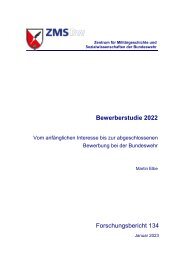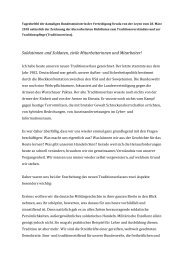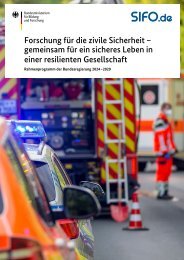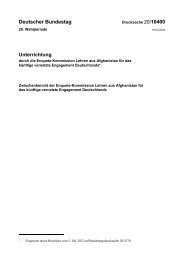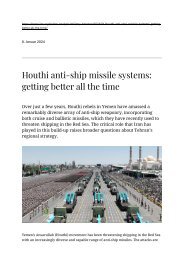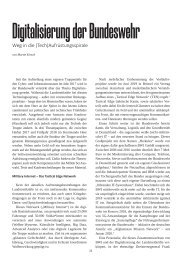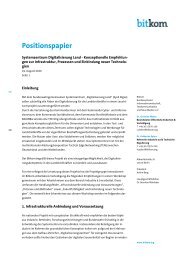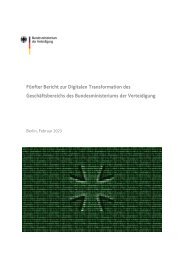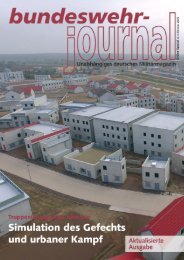EATC
You also want an ePaper? Increase the reach of your titles
YUMPU automatically turns print PDFs into web optimized ePapers that Google loves.
European nations and offering better training<br />
opportunities.<br />
Within the EATF framework, EATT is<br />
an “à la carte”training event,based on training<br />
objectives defined by all participating nations<br />
and dedicated to the whole transport<br />
community.The uniqueness of the EATT<br />
concept attracts an increasing number of<br />
nations that are looking for multinational<br />
training events that match their national requirements<br />
and focus on tactical training objectives.<br />
The <strong>EATC</strong> plays a major role in EATT by<br />
providing a robust expertise and a strong manpower<br />
to each event.<br />
The first two EATT events in 2012 and<br />
2013 were organized in Zaragoza, Spain,<br />
while in 2014 EATT took place in Plovdiv,<br />
Bulgaria. In 2015, the training was settled in<br />
Beja, Portugal. As each EATT requires a lot<br />
of preparation work, two or three different<br />
locations should be identified in the future<br />
in order to decrease the preparation effort.<br />
An incremental training approach<br />
Six nations participated in the first EATT<br />
in 2012; this number increased during the<br />
following events with additional expectations<br />
in the training domain as well.<br />
Furthermore, EATT 2012 only focused<br />
on aircrews, Intel and maintenance training.<br />
In 2013, the EATT Core Planning Team<br />
had to face more challenges due to the increased<br />
number of participants and the variety<br />
of requirements defined by the participating<br />
nations.A dedicated AE training was<br />
implemented and the first academics were<br />
introduced in the event.<br />
In 2014, the training concept was consolidated:<br />
training objectives defined by nations<br />
increased and enabled nations to track<br />
and assess aircrews’ requirements very precisely.Tactical<br />
AE training was performed<br />
by day and night with or without NVG.<br />
Also a dedicated CATO training was part<br />
of the 2014 event. Last but not least, the academics<br />
part was extended and consolidated.<br />
A concept to be consolidated<br />
Based on lessons learned of former events<br />
and the Core Planning Team experience,<br />
EATT 2015 has enabled to consolidate the<br />
global training concept.<br />
In the different areas of air transport, all<br />
participants have the opportunity to be trained<br />
together,learn from each other and work<br />
with common procedures, rules and regulations.The<br />
para panel implemented this year<br />
enabled aircrews to perform more realistic<br />
missions while the multinational panel coordinated<br />
all airborne activities and worked on<br />
interoperability issues.<br />
<strong>EATC</strong> as the Centre of Expertise<br />
For the <strong>EATC</strong>, EATT is more than a training<br />
dedicated to the transport community.<br />
As the laboratory of interoperability, EATT<br />
enables to assess common rules and regulations<br />
as well as common technics, tactics and<br />
procedures that have been developed by<br />
the <strong>EATC</strong> Functional Division’s staff beforehand.<br />
By providing expertise and manpower<br />
into EATT, the <strong>EATC</strong> has gathered a European<br />
transport community around a unique<br />
concept that matches requirements of most<br />
of the European nations.<br />
Finally, from the results reached so far and<br />
the strong willingness of European nations<br />
to consolidate the EATF outcomes, the<br />
<strong>EATC</strong> demonstrates every day that it has<br />
become the Centre of Expertise for air transport<br />
matters in Europe.<br />
EATT/Maintenance<br />
During EATT, the biggest challenge regarding<br />
maintenance is to guarantee A/C availability<br />
in compliance with the flight schedule.<br />
Hence a multinational Maintenance<br />
Operations Centre (MOC) was set up in 2014.<br />
This project came alongside with the creation<br />
of a multinational Aircraft Cross-Servicing<br />
training (ACS), in 2014 as well.<br />
These initiatives also help to improve multinational<br />
cooperation, exchange technical<br />
knowledge and experience. In this respect,<br />
EATT is the ideal occasion to try out concepts<br />
developed during, for example, <strong>EATC</strong><br />
interoperability studies.<br />
Maintenance Operations Centre<br />
The neuralgic spot of EATT’s maintenance<br />
is the so-called MOC, Maintenance Operation<br />
Centre. Here, under the lead of experts<br />
from the <strong>EATC</strong>, maintenance representatives<br />
out of participating nations and<br />
host nation coordinate all maintenance activities,<br />
including aircraft cross-servicing,<br />
cross-maintenance, exchange of spare parts<br />
and pooling and sharing of ground support<br />
equipment.<br />
Aircraft Cross-servicing training<br />
ACS is the execution of services by the maintenance<br />
team from nation A on an aircraft<br />
from nation B. It aims at providing operational<br />
commanders with a flexible and<br />
rapid regeneration of aircraft through interoperability.<br />
During EATT14, this concept<br />
has been implemented by embedding one<br />
to two mechanics from one nation into another<br />
nation’s maintenance organization.<br />
This trainee would execute an “on the<br />
job training” (OJT) with his foreign colleagues.<br />
This OJT consists of marshalling<br />
the aircraft for arrival or departure, fitting or<br />
removing the safety pins, connecting the<br />
ground support equipment or even refuelling<br />
the aircraft.After the successful completion<br />
of this aircraft cross-servicing train-<br />
29



